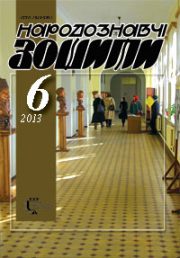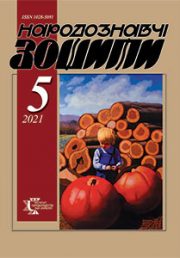The Ethnology Notebooks. 2024. № 4 (178), 843—853
UDK 94(477):[174:168.3]
DOI https://doi.org/10.15407/nz2024.04.843
CRITERIA OF SCIENTIFIC ETHICS IN DEBATING THE ISSUE OF UKRAINIAN ETHNOGENESIS
BALUSHOK Vasyl
- ORCID ID: https://orcid.org/0000-0003-1362-8270
- PhD in History, Senior Research Fellow,
- Maksym Rylskyi Institute of Art Studies, Folklore Studies and Ethnology
- National Academy of Sciences of Ukraine,
- 4, Hrushevsky Str., 01001, Kyiv, Ukraine,
- Contacts: e-mail: grigras@i.ua
Abstract. The solution to the problem of the Ukrainian ethnogenesis hypothesized by the author of this article was fiercely criticized by Leonid Zalizniak who insists that it contradicts not only the principles of scientific research, but also scientific ethics. But, in fact, the opponent does not take into consideration either the theoretical foundations, the applied methods of scientific research, or the author’s analysis of the cultural situation at times of the formation of the Ukrainian nation. He demonstrates ignorance of most of the theoretical basics of ethnology, does not realize the importance of the complex approach to investigating the sources of ethnogenesis, as well as he does not comprehend the notion of ethnogenetic synthesis. L. Zalizniak underestimates the role of ethnic identity in the formation of an ethnic community, considering ethnogenesis the process of the «birth» of an ethnic group. This process is actually endless, as it lasts up to the «disintegration» of a people. According to the concept of L. Zalizniak, all major European ethnic groups originated 1500 years ago. Having no arguments, he declares this process a universal law of the development of peoples living in the middle part of Europe. He draws his own conclusions grounded mostly on the archeological data, while it is now axiomatic to use the complex approach to the sources in ethnogenetic studies. Criticizing the concept of the Ukrainian ethnogenesis suggested by the author of this scientific issue, L. Zalizniak composes complete sentences from the abstracts drawn out of context, and, thus, attributes the following statements to V. Balushok: as to the existence of a formed state as a necessary counterpart of ethnogenesis, as to the author’s alleged denial of the contribution of outstanding Ukrainian scientists to the study of the Ukrainian ethnogenesis. Besides, L. Zalizniak declares him an adept of the stalinism, russian chauvinism, and the like. L. Zalizniak refers to the well-known concept of «meta-ethnic community» in world ethnology, which is used by his opponent, and portrays him as a supporter of the so-called theory of «ancient Rus’ nationality». Besides, having no reasonable grounds, he accuses the opponent of geographical determinism and attributing the beginning of Ukrainian ethnogenesis to a later period, etc. We consider L. Zalizniak’s ultimate goal is to artificially create the concept of the Ukrainian «elder brother» on the scale of the entire Slavic land. The author himself, in our opinion, at best can be recognized only as a popularizer and compiler, but by no means a serious researcher of Ukrainian ethnogenesis.
Keywords: Ukrainian ethnogenesis, ethics of debates, correctness, integrity.
Received 25.07.2024
REFERENCES
- Chubaty, M. (1964). Princeli Rus’-Ukraine and the emergence of three East Slavic nations. New York; Paris: Scientific Society named after Shevchenko [in Ukrainian].
- Polonska-Wasilenko, N. (1970). Two conceptions of the history of Ukraine and Russia. Munich: Ukrainian Free University [in German].
- Shevchenko, F.P., Smoliy, V., & Boryak, H.(2014). On some questions of the history of Ukraine. In: Shevchenko, F.P. Historical studies (To the 100th anniversary of his birth) (Pp. 367—370) Kyiv: Institute of History of Ukraine, National Academy of Sciences of Ukraine [in Ukrainian].
- Brychevskyi, M.Yu. (1968). Origin of Rus’. Kyiv: Naukova dumka [in Ukrainian].
- Dashkevich, Ya. (1993). Echo of the ages: three views on the past and present of Ukraine. Ukraine. Science and culture (Vol. 26—27, рр. 48—52). Kyiv: Znannia [in Ukrainian].
- Shevelyov, Yu. (1994). Why the Obschеrussky language and not the Vibchorus language?: On the problems of East Slavic glottogony: Two articles on the emergence of the Ukrainian language. Kyiv: Ed. House of KM Academia [in Ukrainian].
- Isaevich, Ya. (1996). Ukraine, old and new: people, religion, culture. Lviv: Institute of Ukrainian Studies named after I. Krypyakevych [in Ukrainian].
- Baran, V. (1998). Ancient Slavs. Kyiv: Alternatives [in Ukrainian].
- Pavlyuk, S. (2006). Ethnogenesis of Ukrainians: an attempt at theoretical construction. Lviv: Institute of Ethnology of the National Academy of Sciences [in Ukrainian].
- Pivtorak, G. (2001). The origin of Ukrainians, Russians, Belarusians and their languages: Myths and truth about three Slavic brothers from the «common cradle». Kyiv: Academy [in Ukrainian].
- Ivangorodskyi, K.V. (2018). Ethnic history of Eastern Slavs in modern historiography (Ukrainian, Belarusian and Russian discourses). Cherkasy: Ed. Yu. Chabanenko [in Ukrainian].
- Tolochko, P.P. (2005). Old Rus’ nationality: imaginary or real. St. Petersburg [in Russian].
- Balushok, V. (2004). Ethnogenesis of Ukrainians. Kyiv: IMFE NAS of Ukraine [in Ukrainian].
- Balushok, V. (2008). Ukrainian ethnic community: ethnogenesis, history, ethnonym. Bila Tserkva: Publisher O.V. Pshonkivskyi [in Ukrainian].
- Figurny, Yu. (2011). Professional analysis of the problem of the origin of Ukrainians and professional study of Ukrainian ethnic, nation-building and state-building processes by scientists of the Department of Ukrainian Ethnology of the NNDIU of the Ministry of Education and Science of Ukraine at the end of the 19th and the beginning of the 21st century. Kyiv: NNDIU [in Ukrainian].
- Zaliznyak, L. (2023). The Kyivan Russian version of Ukrainogenesis: «for» and «against». Ukrainian studies, 1, 93—107 [in Ukrainian].
- Klein, L.S. (1988). Strategy of synthesis in research on ethnogenesis (integration of sciences and synthesis of sources in solving problems of ethnogenesis). Soviet ethnography, 4, 13—23 [in Ukrainian].
- Moore J.H. Putting Anthropology Back Together Again: The Ethnogenetic Critique of Cladistic Theory. American Anthropologist, 1994, vol. 96, no. 4, P. 925—948.
- Hornborg, A., & Hill, J.D. (Eds.). (2011). Introduction: Ethnicity in Ancient Amazonia. In:Hornborg, A., & and Hill, J.D. Ethnicity in Ancient Amazonia. Reconstructing Past Identities from Archaeology, Linguistics, and Ethnohistory (Pp. 7—14). Boulder: University Press of Colorado.
- Smith, E.D. (1994). National identity. From English translation P. Taraschuk. Kyiv: Osnovy [in Ukrainian].
- Yevtukh, V.B. (2012). Ethnicity: an encyclopedic guide. Kyiv: Phoenix [in Ukrainian].
- Zaliznyak, L. (2004). From the Sklavyns to the Ukrainian nation. The second edition. Kyiv: Bib-ka Ukrainian [in Ukrainian].
- Zaliznyak, L. (2001). Problems of ethnogenesis of Ukrainians from the standpoint of modern European ethnology. Magisterium. Archaeological studies, 6, 49—56 [in Ukrainian].
- Arutyunov, S.A. (2000). Cultures, traditions and their development and interaction. Lewiston; Queenston; Lampeter: The Edwin Mellen Press [in Russian].
- Posern-Zielinski, A. (1979). Concepts of ethnicity in American ethnic studies. Lud: Yearbook of the Polish Ethnological Society (Vol. LXIII, pp. 3—23). Wroclaw [in Polish].
- Isaevich, Ya. (2007). The princely age and the Middle Ages: how do these definitions coincide. Princely age: history and culture. Lviv: Institute of Ukrainian Studies named after I. Krypyakevych, 1, 3—12 [in Ukrainian].
- Brook, S.I. (1981). World population: Ethnodemographic directory. Moscow: Nauka [in Russian].
- British History in depth: The Ages of English. Retrieved from: https://www.bbc.co.uk/history/british/lang_gallery_04.shtml (Date of the application 28.04.2024).
- Adadurov, V. (2002). History of France. The royal state and the creation of the nation (from the beginning to the end of the 18th century). Lviv: Ukrainian Catholic University Publishing House [in Ukrainian].
- Zelenchuk, V.S. (2002). Problems of the internal structure of the ethnic group (Romanians-Moldavians). Museum. Traditions. Ethnicity. XX—XXI centuries Materials of the International Scientific Conference dedicated to the 100th anniversary of the Russian Ethnographic Museum (Pp. 179—183). Saint Petersburg; Chisinau [in Russian].
- Gensyorsky, A.I. (1962). The term «Rus» (and its derivatives) in Ancient Rus during the formation of East Slavic peoples and nations. Research and materials on the Ukrainian language, 5, 16—30 [in Ukrainian].
- Kryukov, M.V. (1976). Evolution of ethnic identity and the problem of ethnogenesis. Races and peoples, 6, 42—63 [in Russian].
- Woodman, P. (2009). The Nature of the Endonym. United Nations Group of Experts on Geographical Name. 25 Session Nairobi. 5—12 May. Working Paper 1 (Pp. 11—18).
- Presnyakov, A.E. (1918). Ukraine. Bulletin of culture and politics. Petrograd [in Russian].
- Pashuto, V.T. (1950). Essays on the history of Galician-Volyn Rus. Moscow: Publishing House of the USSR Academy of Sciences [in Russian].
- Golovko, O. (2017). Prince Mstislav Mstislavich «Udatny» and his era. Kamianets-Podilskyi: Axiom [in Ukrainian].
- Hrushevskyi, M. (1991). History of Ukraine-Rus (Vol. 1).Kyiv: Naukova dumka [in Ukrainian].
- Balushok, V. (2005, april 22). When was the Ukrainian nation born? Mirror of the week, 15 [in Ukrainian].
- Arutyunov, S.A. (1989). Peoples and cultures: development and interaction. Moscow: Nauka [in Russian].
- Balukh, V., & Kotsur, V. (2011). History of the Middle Ages:.in 2 vol. (Vol. 2: High and late Middle Ages). Chernivtsi: Our Books [in Ukrainian].
- Sahlins, M.D., Manners, R.A., & Kaplan, D. (2 eds.). (2009). Evolution: specific and general. Anthropological Theory: A Sourcebook (Pp. 229—241). New Brunswick and Lindon.
- Arutyunov, S.A. (1993). Adaptive significance of cultural polymorphism. Ethnographic review, 4, 41—56 [in Russian].
- Arutyunov, S.A., & Khazanov, A.M. (1979). The problem of archaeological criteria of ethnic specificity. Soviet ethnography, 6, 79—89 [in Russian].
- Kovalevskaya, V.B. (1984). The Caucasus and Alans: centuries and peoples. Moscow: Nauka [in Russian].
- Springer, M. (1990). On the conceptual foundations of Germanic research. Treatises and reports from the Dresden State Museum of Ethnology, 44, 169—177 [in German].
- Gavrilyuk, N.O. (Ed.). (1996). Ethnogenesis. Archeology reference dictionary (P. 80). Kyiv: Naukova dumka [in Ukrainian].
- Gumilyov, L.N. (1990). Geography of an ethnic group in the historical period. Leningrad: Nauka [in Russian].
- Bagnovskaya, N.M. (2002). Sevryuks: the population of the Seversk land in the XIV—XVI centuries. Moscow: Paleotype [in Russian].
- Pivtorak, G. (2001). The origin of Ukrainians, Russians, Belarusians and their languages: Myths and truth about three Slavic brothers from the «common cradle». Kyiv: Academy [in Ukrainian].
- Singh, G. (2000). Ethnic Conflict in India: A Case-Study of Punjab. New York: Palgrave.
- Zaliznyak, L. (2008). The origin of Ukrainians: between science and ideology. Kyiv: Tempora [in Ukrainian].






